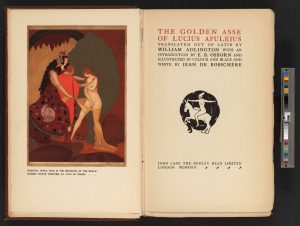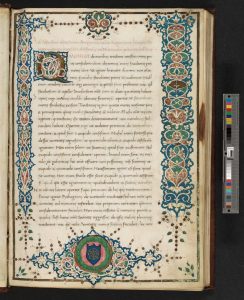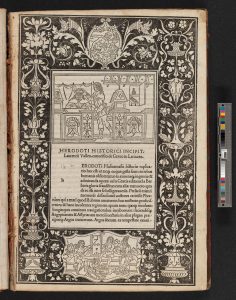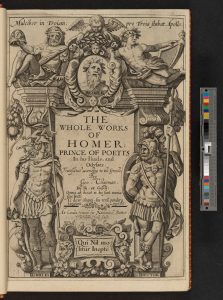Collection Overview

Frontispiece illustration of ‘Celestial Venus’ done by Jean de Bosschere for a 1923 translation of Apuleius’s Metamorphoses.
The Rare Book Collection’s (RBC) Greek and Latin languages holdings consist of a wide array of materials ranging from artifacts of antiquity to Medieval and Renaissance manuscripts to scholarly editions of Classical authors published in the mid-twentieth century. Well-represented are printed editions of the authors of Greek and Roman antiquity from the fifteenth century to the present day, with a heavy concentration of literary and philosophical works produced in the sixteenth century and still in their original bindings. The depth and breadth of this subset of the RBC affords students and scholars the opportunity to trace the progression of a particular author’s work over the course of 500 years. Such holdings encourage a better understanding of the history and transmission of each work and also of their continued cultural influence. Examples of such influence range from the production of English translations to the creation of modern fine press editions with illustrations by notable artists and illustrators.
While the majority of Greek and Latin language materials can be found in the general Rare Book Collection, significant editions can also be found in the Estienne Collection, which documents the output of a family of sixteenth-century printers and publishers dedicated to the spread of ancient learning throughout Europe. Additional printers represented include Aldus Manutius and his successors, John Baskerville, the House of Elzevir, and William Morris. Many of the early Greek and Latin books and manuscripts come from the foundational gift of incunabula (books printed before 1501) from the Hanes family of Winston-Salem in 1929. While others, used by generations of students long before the formal creation of the RBC, originated in the libraries of the Dialectic and Philanthropic Societies.
Greek Authors

Detail of an illuminated page from Wilson Library MS.92 containing Aristotle’s Magna Moralia and Metaphysics. Produced in Florence between 1455 and 1459.
Latin Authors
Latin language materials are slightly more plentiful in the RBC than their Greek counterparts and focus on subjects that comprise the Classical Trivium: grammar, logic, and rhetoric. Also included are examples of religious and devotional materials in Latin, specifically bibles and sermons in Latin, both in print and manuscript. Representative authors include St. Jerome, St. Thomas Aquinas, St. Augustine, Catullus, Cicero (in print and manuscript), Livy, Lucretius, Seneca, and illustrated fifteenth-century editions of Dante in Latin. Best represented are Horace, Ovid, and Virgil, required reading for countless Carolina students since the University’s founding, with works of all three authors present in editions from the first decade of the sixteenth century to fine press editions released at the turn of the twentieth century. Author C. S. Lewis’s heavily annotated personal copies of Classical texts are also housed within the RBC as the C. S. Lewis Collection. They showcase the working library of a Classical scholar working in early-twentieth century.
Translations into English

Intricate woodcut border on the title page of the third printed edition of Herodotus’s History (Venice, 1494).
The RBC holds a considerable number Greek and Latin texts translated into English and other languages, primarily French. Dating mainly from the seventeenth and eighteenth centuries, these translations demonstrate the influence of Classical authors in Early Modern England. Scholarly significant translations include George Chapman’s The Whole Works of Homer (1616), Alexander Pope’s Iliad (1715-1720) and Odyssey (1725-1726), and John Dryden’s Works of Virgil (1697). Also included in this grouping are early-nineteenth-century editions of Homer which feature fore edge paintings.
Other Subjects
Greek and Latin imprints in fields such as math, science, and natural history can also be found in the general RBC, Estienne collection, and the recently gifted Florence Fearrington collection, which has a special focus on malacology and Wunderkammers. These materials cover an equally lengthy period, beginning with a manuscript collection of astrological and mathematical treatises dating to the fourteenth century to ephemeral guidebooks, maps, and books of the late-twentieth century.

Title page of George Chapman’s 17th century English translation of Homer’s works. This edition inspired John Keats’s famous poem: “On First Looking into Chapman’s Homer.”



